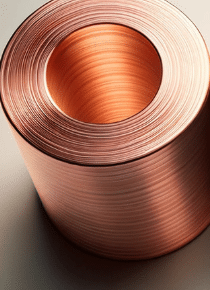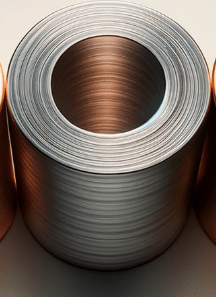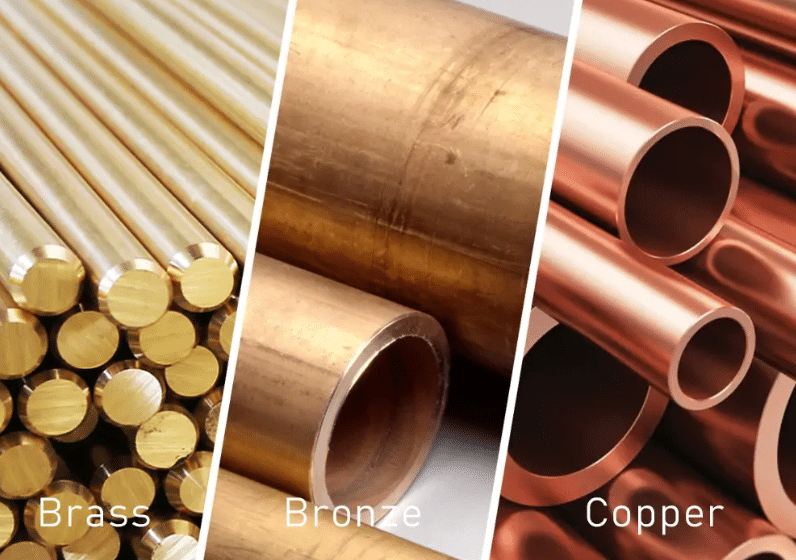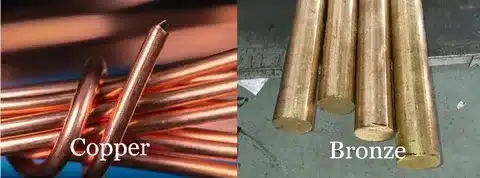Meta Description: Find the main distinctions between the brass bronze and copper colors, along with their high corrosion resistance., including their high corrosion resistance and the properties of copper alloys, as well as their good corrosion resistance and the use of protective coatings. . , in the given complete guide, highlighting the unique features of this copper based material, making it a suitable material for various applications. and its utility, including applications in musical instruments . . Discover their origins, uses and uses, psychological effects and effective use in design, architecture and product manufacturing.

Speaking of cozy, elegant metallic shades, the colors of copper, brass bronze and copper, and bronze may be viewed as two of the most popular and universal options in design, architecture as well as manufacturing spheres. All of these earthy hues have enchanted humankind throughout thousands of years, and each of them has a personality and a specific way to use. The knowledge of the distinct properties and differences between copper and bronze colors, especially their excellent corrosion resistance, as well as their relationships with brass and bronze, is imperativ . is imperative to the designers, architectures, manufacturers, and anyone who deals with metallic paintwork, including brass alloys and bronze .
What Defines Copper Color?

The copper color has an identity based on the natural metal, the copper color of the only natural metal, oxygen free copper, or pure copper metal., along with other red metals. and its copper alloys. that is which bronze exhibits is characterized by warm reddish-orange color shade. There is something bright and vibrant about this color and instantly draws attention because of its warmth and energy. The natural oxidizing of pure copper which occurs with time produces differences in the various tones of pure copper, penny-copper to reddish-browns, deeper and more mellow.
The copper color group includes bright shades which are almost orange-red to the dark shades which are brownish red. These applications suit copper color especially when you want a suitable metal that provides warm and lively shade of color which would provide a welcoming mood with a luxurious yet down to earth feel, showcasing its unique properties. .
Understanding Bronze Color Characteristics

Bronze color on the other hand takes a more elaborate and superior look just like the alloy of bronze metal itself. True bronze color, which is an alloy primarily composed, can also include brass alloys like brass bronze. and copper aluminum bronze alloys based on its element composition. , contains both the warm and cool properties in equal balance of the copper-based color, which is often reflected as a rich brown with the golden or greenish reflections that give it a gold like appearance . This is what makes bronze have the elegant and beautiful depth.
The hues of copper color furnishings are sometimes on the side of the dull and restrained and in the case of bronze color they are highly sophisticated giving a great amount of elegance that resonates well in formal scenarios. Bronze colors, particularly in marine environments, usually do have slight variations, which can seem to change with a change in ambient light source and coloring, highlighting their wear resistance, the importance of protective coatings, and the potential for further corrosion. . , and make them even more interesting and visually interesting.
Historical Origins and Cultural Significance
The color copper and the color bronze have their deep historical implications that affect their current visualisation and use. Copper, particularly the naturally occurring copper as one of the initial pure elemental metals, copper brass and bronze, used by man., symbolizes innovation, creativity, endurance, and high electrical conductivity. Copper is extremely useful, hence valued in ancient society, but also because of its aesthetic qualities, it was a metal often associated with affluence and prestige.
Bronze as a mixture of copper with tin is identified with human development and even Bronze age. Such a rich history lends bronze color seriousness and elegance, which make it an adequate material to use in commemorative work, prizes and high-end architectural features.
Color Composition and Technical Differences

Technically speaking, the copper color is defined by a particular spectrum of wavelengths absorption that determines the appearance of a reddish/orange color. The tone usually has the highest thermal conductivity compared to the lowest thermal conductivity of other metals. , high values of red and some moderate orange values with a little bit of blue undertones. Copper colors in digital programs tend to highlight red and yellow parts, along with RGB values.
Bronze composition of color is more complicated in that it involves maximum absorption of its spectrum to give the multi-faceted look. Bronze hues tend to be balanced brown with a subtle metallic reflection, and even undertone balance is important to look correct, especially in marine components. .
Visual Impact and Aesthetic Appeal
The visual impression of the color copper and bronze varies a lot both in emotional and aesthetic influence. The color copper is stimulating and makes a point of focus and is eye grabbing and can brighten up areas. This is why copper is better used in smaller items, decorations, and even musical instruments where the mechanical properties and visual effect is made the main concern.
Bronze color has a more mature visual response but is less intense giving it depth and richness without dominating the rest of the designs. It is this feature that makes bronze especially applicable in integrated design plans where harmony and balance is relevant.
Applications in Interior Design
Copper and bronze color in usage in the interior design have disparate uses and generate varied atmospheres. Copper colour best fits modern and industrial design plans, where it will add a suitable warmth to the tends of the modern environment, making it ideal for plumbing fixtures, particularly general usage brass . , particularly when suitable with compatible manufacturing processes. , forging some exciting contrasts with the more cooling paper and steel, or glass.
Bronze color belongs to more traditional and transitional style of design and provides classic elegance that suits old and new furniture, reminiscent of a dull gold color. . This bronze finishes suit best in the formal dining room, libraries and those places that require sophisticated atmosphere.
Architectural and Construction Uses
Copper and bronze colors are used in architecture differently in order to achieve different effects. Roofing, gutters, and outdoor detailings are commonly coated with copper, copper-colored coatings commonly used due to their visual attractiveness along with weather resistance. The patination process of copper fades and gradually makes the structure of the building rich with color stories as building ages.
Sometimes bronze color may be found in architectural hardware, lighting and ornamental features. The elegant looks of bronze give it the fair complexion of high quality residential and commercial purposes that improves permanence and prestige.
Manufacturing and Industrial Applications
Copper color and bronze color, including copper alloys, are used in manufacturing facilities as well as in creating decorations. Finishes, which are copper-colored, are also the likely signs of actual electrolytic copper contents and how they compare to other elements. , as the visual references about material properties and performance characteristics. This is especially needed in electrical sections where conductivity of copper is a vital necessity.
Manufacturing Bronze-colored finishes are popular choices in the manufacturing industry because they are usually strongly associated with longevity and accuracy, and tools, hardware and mechanical ones are particularly often painted in bronze. Bronze color is also related to strength and because of this attribute it is useful in places where performance and reliability is of essence.
Founded in 1995, GWT Worldwide offers international logistical solutions in Shenzhen Guanwutong International Freight Forwarding Co., Ltd which deals with shipping copper and bronze-finished products. We are a professional logistic service provider, and we have realized the need of ensuring the right handling and shipment of metallic- finished goods so as to retain their appearance and quality when transported to destination abroad.
Psychological Effects and Color Psychology
Psychology of copper verses bronze colors contributes to the ultimate usefulness of such colors in various applications. Copper color is generally inspiring, and energy and creative potential as well as warmth hence, effective in social places due to its strong corrosion resistance, even in corrosive environments . and any place where creative work is carried out. An intensity of red metals like copper can be regarded as an element that enhances perceived warmth and relaxation.
Bronze color psychology is inclined to stability, sophistication and trustworthiness. These associations give bronze a real advantage in a professional setting, high structural integrity luxury scenarios, and the context in which credibility and durability are key messaging objectives.
Lighting Considerations and Color Rendering
The lighting has a substantial influence on the view of both copper and bronze colors and both behave differently according to lighting sources. Copper colors usually come out more vibrant when in warm lighting conditions and cooler lighting may nullify the distinctive warmth of the copper coloring it and making it seem much more orange or red instead.
Bronze colors are more complex in diverse lights, and the multidimensional presence in them would enable them to accommodate different lighting situations without losing their posh look. Appreciation of such lighting interactions is quite essential in the successful application of the same.
Pairing and Complementary Colors
Strategies of color pairing between copper and bronze are also remarkably different with each side having its own advantages in the way of finding combinations. Dark blues, forest greens, creams, and copper tones blend wonderfully together to provide gorgeous, warming color schemes that are perfectly welcoming yet classy at the same time.
Earth-tones, deep burgundies, and sage greens are among the colors best complemented by bronze shades in making fancy color schemes that are of classic taste and classy. Bronze is a good bridging color between cooler and warmer elements on the palette being a neutral color, bronze shades also work well for heat sinks. .
Maintenance and Durability Factors
Copper and bronze coloured finishes, including common bronze alloys, should be considered in view of maintenance requirements depending on the application and manufacturing processes used to complete the finish. The copper finishes might have to be more frequently maintained to keep the bright finish especially when they are used outdoors; weathering might influence the color uniformity.
The tin bronze colours are generally more long lasting and less expense to maintain, in part perhaps because such finishes are less showy, and because their colour mixture renders small variations of wear and maturing patination more easily concealable.
Cost Considerations and Budget Planning
The choice of the copper or bronze color has a lot to do with budget implications, where the intended application requires a particular finishing method. True copper finishes generally have a top-tier price reflecting the cost of materials and expertise needed to apply them, bronze finishes can be competitively priced on a project-by-project basis based on the alloy involved.
These cost factors are crucial to the project planning and facilitate the approach of meeting this goal with regard to all the project goals in mind, as well as ensuring that color selection is within the financial capacity of the entire project life cycle.
Digital and Print Color Reproduction
The reproduction of copper and bronze color poses special problems in digital and print reproduction because of the metallic nature, and the light interaction characteristics. Copper colors sometimes need to be calibrated closely to not be too orange or too red in forms of digital production.
Recreation of bronze color requires consideration of undertones balance and slight highlight features which provide bronze with sense of depth and refined beauty. Where copper or bronze in many forms of media needs to be reproduced consistently in color, professional colour management is needed.
Trends and Future Directions
The modern design trends are indicating growing popularity of both copper and bronze colours, with copper becoming especially widespread in the modern housing design. Copper with its inviting, friendly texture is a perfect match with all the current trends of lived-in luxury.
Bronze has retained its standing as a refined high-end alternative and the developing trend is toward textured and aged bronze finishes providing both visual drama and tactile interest due to their metallic nature. to conventional bronze hue treatments.
Sustainability and Environmental Impact
The issue of environmental considerations is becoming an important factor in color choices and both copper and bronze colors present benefits in the sustainable design strategies, along with the considerations of three metals . The recyclability and durability of copper, along with its thermal and electrical conductivity, makes copper-colored finish popular over projects that are environmentally concerned.
The durability and age-less nature of bronze add to sustainable design in that one does not have to update and replace mostly due to the current trends of using durable and long lasting design solutions.
Regional and Cultural Preferences
The application of copper over brass and bronze colours differ greatly in various markets because of cultural and regional differences in preferences. certain cultures are copper with wealth and good fortune, while others, such as those utilizing naval brass, are appreciative of bronze, as it is historical and associated with accomplishment.
It is well known that in a global market it is especially significant to understand such cultural peculiarities about the color choices because in such a case it is necessary to be responsive to different people and cultures.
品質基準と仕様
Quality specifications of copper and bronze colored finishes differ considerably according to the application and environment in which the brass bronze and other materials are expected to be used in. Professional standards should touch on protection against wear and tear, color tolerance, performance in different environments.
Setting out exact quality standards can assist in recording that whether decisions about copper and bronze colour undertaking will pass aesthetic and practical test throughout the proposed service requirement.
Professional Application Techniques
The effective use of tellurium copper, copper and bronze colors, along with their unique properties, cannot be applied without mastering some professional techniques and best practices that involve alloying elements. related to every single metal alloy color group. The use of copper color usually aims at the creation of continuity of richness and warmth and the control of the orange or red color tendency.
The use of bronze color usually focuses on the depth aspect and the undertone balance, which need the skill to bring out the depth, complex and multifaceted look typical of a tin based alloy. that is characteristic of good bronze titles.
Common Mistakes and How to Avoid Them
The typical errors made in the use of copper and bronze color, particularly regarding saltwater corrosion resistance, are not taken into account from the point of view of lighting, selection of colors, and not considering the problems of maintenance. Knowledge of these possible pitfalls goes a long way toward the successful results of any copper or bronze color project.
To be able to avoid these pitfalls, one should plan extensively, seek professional advice where necessary, be realistic in maintenance and long-term considerations of each color selection.
Industry Standards and Best Practices
The standards of the color of the copper and bronze industry also keep updating with new methods of use and with new materials. Keeping up with these standards keeps color implementation on par as far as professional expectations and long-term performance is concerned.
The best practices point to the significance of surface preparation, finishing techniques, and routine maintenance procedures, which would retain the color look and the service life performance attributes.
結論
The decision of selecting copper or bronze color lies on the requirements of the particular application, beauty intention, and functionality of a particular project. Copper color can be described as vibrant and heating and it is an excellent color in modern applications and places where color should have an impact. Its barring, approachable temperament makes it flawless to make soothing atmospheres and centres.
Bronze color offers elegance and classic style which are highly useful in official uses and circumstances when durability and prestige are the keys. The sophisticated and not quite straightforward character of bronze makes it especially apt in high-end applications where your sophistication is more important than the brass vs visual punch that it creates.

